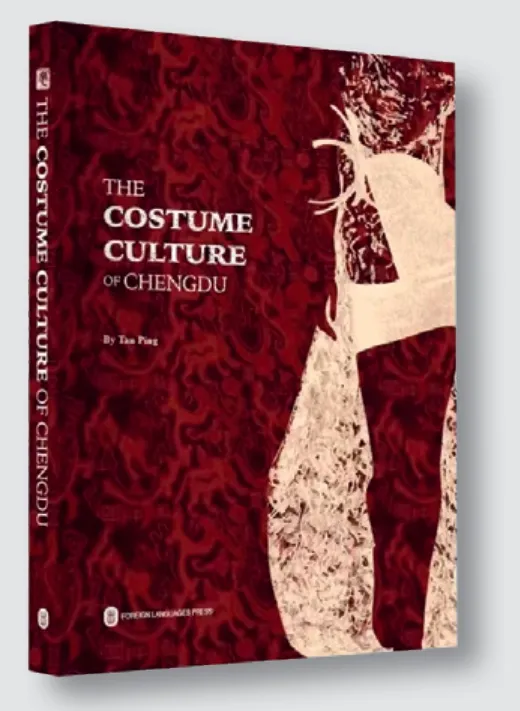The Charm of Chengdu Costume
By staff reporter ZHOU LIN

The Costume Culture of Chengdu
Author: Tan Ping
Paperback,235 pages
Published by Foreign Languages Press
As one of the earliest regions in the world to plant mulberry trees and raise silkworms,Chengdu in southwest China’s Sichuan Province,with a civilization of over 4,500 years,has been a hub of exchanges of Eastern and Western cultures since ancient times.Today,it is one of the most vibrant and prosperous cities in China.
The Costume Culture of Chengduexplores Chengdu people's understanding of the meaning and beauty of life through clothing,and presents the apparel stories behind its rich myths.It serves as a window for foreign readers to understand Chengdu’s ancient and modern clothing culture.
The book is divided into four chapters: Historical Wealth,Cul-tural Imprint,Natural and Humanistic Endowments,and Dialogue of Civilizations.
The first chapter begins with some of the most representative studies in archaeology and history to see why people in Chengdu are so proud of their clothing culture and history.For example,headwear is a significant part of their attire,coming in countless shapes and designs,both in ancient and modern times.In Chengdu,archaeologists have unearthed the largest cache of the biggest and the most mysterious metal helmet used by tribal chiefs more than 3,000 years ago.
More than 300 years before the birth of Christ,the Shu Kingdom was flourishing in the Chengdu Plain.According to scholars,the ancient Shu people wore not only various kinds of headwear and costumes,but also ornaments.These were distinctive,indicating that a dressing system had been formed.The dressing system,closely connected with the economic and social development of the kingdom,reflected its cultural prosperity and splendor during the Bronze Age.
The Shu brocade produced in Chengdu is well-known in Chinese history.It represented the top level of ancient Chinese handmade silk.Brocade was used for the outer garments and gave a distinctive aura of beauty and sophistication.It was regarded as the best fabric for making clothes.The most prominent period of Shu brocade was during the Tang (618-907) and Song (960-1279) dynasties.In Tang,the central government presented brocade robes as rewards or gifts to the heads of the tribes who surrendered to them and also to friendly neighboring countries.
The second chapter focuses on how Chengdu’s costumes have been mentioned in various myths,legends,historical documents,and literary and artistic works,forming a collective memory full of imagination and creative aesthetic ideas.
Yellow Emperor,the Chinese people’s legendary ancestor,is said to have lived in the late period of China’s primitive society about 4,800 to 4,600 years ago.His wife Leizu was revered as the “Lady of the Silkworm” for her discovery of silk and the invention of the silk loom.The Chengdu Plain was named Shu because Leizu once taught how to make silk there.Shu literally means “undomesticated silkworms,” and the silk thread produced there was the earliest raw material for making silk fabrics.Silkworms were one of the totems of the ancient Shu Kingdom.
During the Han Dynasty (206 BC-AD 220),Chengdu was one of the top five metropolises in China.Chengdu residents,nobilities and commoners alike,dressed themselves beautifully.Many people lived on their weaving skills and weaving workshops lined the streets,humming with the sound of looms.Shu brocade boasted unparalleled beautiful colors and patterns.They were soft and delicate and could be used to make various kinds of garments.The fine yellow Chengdu linen was so precious that just a few pieces were worth a sum of gold.
The third chapter talks about the unique natural and human resources of the Chengdu Plain which provided ample inspiration for the development of Chengdu’s costume culture.Long known for its rich natural resources and prosperity,Chengdu and its surroundings were called the “land of heavenly abundance” (tianfuin Chinese),which was the cradle of the “tianfuculture.”
The Chengdu Plain,the most fertile region in the Sichuan Basin and the most suitable area for human habitation and development in the upper reaches of the Yangtze River,laid a solid foundation for the development of Chengdu costume.
Owing to the Dujiangyan irrigation system,the greatest hydraulic project in China,Chengdu abounds in water resources and thus has suffered no major floods for more than 2,000 years.No wonder that the irrigation system is called the “world wonder of water conservancy.”
In addition,Chengdu’s mild climate is also favorable for the development of its costume.The women of Chengdu have enviable skin due to the mild climate.In the past,to show off their beauty,they would spend time on their hair,ornaments,and eyebrows,and vie to dress beautifully and distinguishably.
In the fourth chapter,the author discusses the topic of Chengdu costume as a means to promote dialogues among civilizations.For more than 2,000 years,Chengdu was an important city for foreigners to discover the beauty of Chinese clothing.For example,Shu brocade and embroidery were the top-rated exported products on the ancient Silk Road.About 4,800 years ago,when Sichuan was still under the reign of the ancient Shu Kingdom,Shu linen was exported to India and then resold to Daxia (now Afghanistan).It indicates that the fine linen made in Shu could meet the needs of people there with its excellent quality and strong production capability.
Today,Chengdu is the largest apparel base in western China for costume design,production,exhibition and sales.In 2018,Chengdu was listed as the China Fashion First-tier City in the China Urban Fashion Index Report.With its synergy of traditional culture and fashion trends,history and modernity,Chengdu is an active player in the fashion industry.
The Costume Culture of Chengdu,with its vibrant illustrations and fascinating stories,is an invaluable resource for readers to understand the past and present of the traditional costume culture of Chengdu.And it is a must-read for those who are infatuated with traditional Chinese clothing.

